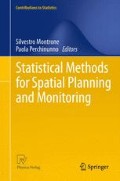Abstract
A great part of statistical techniques has been thought for exact numerical data, although available information is often imprecise, partial, or not expressed in truly numerical terms. In these cases the use of fuzzy numbers can be seen as an appropriate way for a more effective representation of observed data. Diamond introduced a metrics into the space of triangular fuzzy numbers in the context of a simple linear regression model; in this work we suggest a multivariate generalization of such a distance between trapezoidal fuzzy numbers to be used in clustering techniques. As an application case of the proposed measure of dissimilarity, we identify homogeneous groups of Italian universities according to graduates’ opinion (itself fuzzy) on many aspects concerning internship activities, by disciplinary area of teaching. Since such an opinion depends not only on the quality of internships, but also on the local context within which the activity is carried out, the obtained clusters are analyzed paying attention particularly to the membership of each university to Northern, Central, or Southern Italy. [This work is the result of joint reflections by the authors, with the following contributions attributed to Campobasso (Sects. 2.2, 2.3.2 and 2.4), and to Fanizzi (Sects. 2.1, 2.3 and 2.3.1).]
Access this chapter
Tax calculation will be finalised at checkout
Purchases are for personal use only
References
Campobasso, F., Fanizzi, A.: A stepwise procedure to select variables in a fuzzy least square regression model. In: Proceedings of the International Conference on Fuzzy Computation Theory and Applications, Paris, France, pp. 417–426 (2011)
Campobasso, F., Fanizzi, A., Perchinunno, P.: Homogenous urban poverty clusters within the city of Bari. In: Gervasi, O., Murgante, B., Laganà, A., Taniar, D., Mun, Y., Gavrilova, M.L. (eds.) Computational Science and Its Applications – ICCSA 2008, Part I. LNCS, vol. 5072, pp. 232–244. Springer, Heidelberg (2008)
Campobasso, F., Fanizzi, A., Taratini, M.: A proposal for a fuzzy approach to clustering techniques. In: Classification and Data Analysis, Book of Short Papers, University of Padova, Italy, pp. 449–452. Cleup, Padova (2009)
Chen, S.H., Hsieh, C.H.: Graded mean integration representation of generalized fuzzy numbers. J. Chin. Fuzzy Syst. Assoc. Taiwan 5(2), 1–7 (1999)
Chen, S.H., Hsieh, C.H.: Graded mean representation of generalized fuzzy numbers. In: Proceeding of Sixth Conference on Fuzzy Theory and its Applications (CD ROM), Chinese Fuzzy Systems Association, Taiwan, pp. 1–6 (1998). Filename 031.wdl
Chen, S.H., Hsieh, C.H.: Ranking generalized fuzzy number with graded mean integration representation. In: Proceeding of Eighth International Fuzzy Systems Association World Congress (IFSA’99 Taiwan), Taiwan, pp. 551–555 (1999)
Chen, S., Wang, C.: Fuzzy distance of trapezoidal fuzzy numbers and application. Int. J. Innovative Comput. Inf. Control ICIC Int. 4(6), 1445–1454 (2008)
Chiandotto, B., Gola, M.: Questionario di base da utilizzare per l’attuazione di un programma per la valutazione della didattica da parte degli studenti, Italian Ministry of University and Research, Observatory for the evaluation of the Academic System (1999)
Diamond, P.M.: Fuzzy least square. Inf. Sci. 46, 141–157 (1988)
Lalla, M., Ferrari, D., Pirotti, T.: A fuzzy inference system for teaching evaluation. In: Proceedings of the International Conference on Statistical Modelling for University Evaluation: An International Overview, University of Foggia, pp. 27–30 (2008)
Montrone, S., Perchinunno, P., Di Giuro, A., Torre, C.M., Rotondo, F.: Identification of hot spot of social and housing difficulty in urban areas. In: ICCSA 2011. LNCS, vol. 176, pp. 57–78. Springer, Heidelberg (2011)
Zadeh, L.A.: Fuzzy sets. Inf. Control 8(3), 338–353 (1965)
Author information
Authors and Affiliations
Corresponding author
Editor information
Editors and Affiliations
Rights and permissions
Copyright information
© 2013 Springer-Verlag Italia
About this chapter
Cite this chapter
Campobasso, F., Fanizzi, A. (2013). A Fuzzy Approach to Ward’s Method of Classification: An Application Case to the Italian University System. In: Montrone, S., Perchinunno, P. (eds) Statistical Methods for Spatial Planning and Monitoring. Contributions to Statistics. Springer, Milano. https://doi.org/10.1007/978-88-470-2751-0_2
Download citation
DOI: https://doi.org/10.1007/978-88-470-2751-0_2
Published:
Publisher Name: Springer, Milano
Print ISBN: 978-88-470-2750-3
Online ISBN: 978-88-470-2751-0
eBook Packages: Mathematics and StatisticsMathematics and Statistics (R0)

